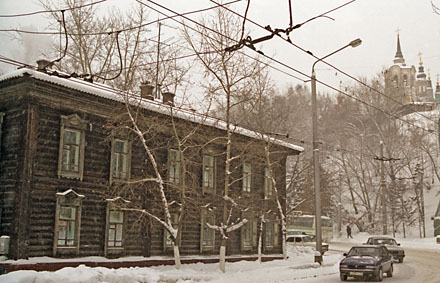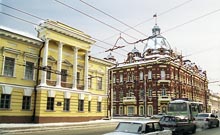Tomsk - history and present
Tomsk is one of the nicest Siberian cities, and, probably, the most typical of them. It came successfully through all stages of what prosperous town in Siberia should be – and while other perished or changed drastically, it has been developing gradually, adding to its charm and power. First military settlement at the eastern border of Russia, than trade and craft town, then administrative and cultural center, and, finally, the city of industry and science.
The military settlement was founded by 200 cossaks in 1604. It was an important outpost in bringing local nomad muslim Tartars under the governance of Russian tsar. As russian expansion moved eastward, and other settlements were founded in the middle of 17th century, the military importance of Tomsk has dropped. But in 1738, it was established as an important staging-post on the Moscow-Siberian Post Road, which gave a thrust for rapid growth of the town. Appeared first warehouses, inns. First located on one fortified hill, the town expanded in area and the most of what are now historical districts were formed. Churches were built in stone, and in the St.Alexey monastery opened first school and library. Next stage of development of the city began in 1804, when Tomsk was chosen as a center for vast administrative region, stretching for thousand kilometers from east to west and from north to south (at present this is territory of  Novosibirsk, Kemerovo, Tomsk, partly Krasnoyarsk regions and the north of Kazakhstan). The region governed from Tomsk was rich in natural resources – wood, furs, fish, honey; agriculture – it had one of the largest butter productions not only in Russia, but had its export to Europe, was also abundant in wheat and other grain-crops; and had numerous copper and gold mines. All this contributed to the prosperity of the city itself, which became the most advanced Siberian city. In the middle of 19th century, there were 8 churches and 50 stone building (which were the rare case in wooden land of Siberia). In 1873 first bookstore in Siberia was opened in Tomsk, soon afterwards appeared public library and typography. In 1888, the first in Siberia University was opened in Tomsk, then, in 1900 – Technical Institute. In the beginning of 20th century, Tomsk was first in Siberia by number of educational institutions (104), there were 4 theaters, 5 cinemas, 7 libraries, 4 newspapers were printed.
Novosibirsk, Kemerovo, Tomsk, partly Krasnoyarsk regions and the north of Kazakhstan). The region governed from Tomsk was rich in natural resources – wood, furs, fish, honey; agriculture – it had one of the largest butter productions not only in Russia, but had its export to Europe, was also abundant in wheat and other grain-crops; and had numerous copper and gold mines. All this contributed to the prosperity of the city itself, which became the most advanced Siberian city. In the middle of 19th century, there were 8 churches and 50 stone building (which were the rare case in wooden land of Siberia). In 1873 first bookstore in Siberia was opened in Tomsk, soon afterwards appeared public library and typography. In 1888, the first in Siberia University was opened in Tomsk, then, in 1900 – Technical Institute. In the beginning of 20th century, Tomsk was first in Siberia by number of educational institutions (104), there were 4 theaters, 5 cinemas, 7 libraries, 4 newspapers were printed.
 But the construction of Trans-Siberian railway in the end of 19th took the leadership off Tomsk. The railway went some 200 kilometers to the south of the city, giving birth to new industrial center – Novosibirsk. Period of stagnation lasted for Tomsk until the World War II, when a number of factories were evacuated there from western part of the Soviet Union. In 1944 Tomsk was reestablished as an administrative center. New impact on the growth of the city gave the beginning of oil and gas fields development in Tomsk region. First oil inflow was gained in 1962, and since then numerous other fields development started, pipelines were constructed, in the north of Tomsk region appeared the city of oilers – Strezhevoy. Tomsk became the residence for enterprises connected with oil and gas mining. The headquarters of notorious Yukos company, whose former head Mikhail Khodorkovsky serves now his term in prison camp, was also located in Tomsk. Another point of growth for the city became its educational potential. Tomsk was dubbed “Siberian Athens” for the number of higher education institutes in the city. At Soviet times each fourth citizen of the city was a student. In the 70s of the last century, Tomsk Scientific Center of Siberian Branch of Academy of Sciences was established, comprising 5 research institutes, and was followed by Tomsk Center of Medical Academy in 1987. Recently Tomsk was chosen by Russian Government as one of four (along with St.-Petersburg and two towns in Moscow region) special economic zones for promotion of high technologies, which should result in construction of cutting-edge tecnological district, that will host leading companies and scientific establishments and foster their collaboration.
But the construction of Trans-Siberian railway in the end of 19th took the leadership off Tomsk. The railway went some 200 kilometers to the south of the city, giving birth to new industrial center – Novosibirsk. Period of stagnation lasted for Tomsk until the World War II, when a number of factories were evacuated there from western part of the Soviet Union. In 1944 Tomsk was reestablished as an administrative center. New impact on the growth of the city gave the beginning of oil and gas fields development in Tomsk region. First oil inflow was gained in 1962, and since then numerous other fields development started, pipelines were constructed, in the north of Tomsk region appeared the city of oilers – Strezhevoy. Tomsk became the residence for enterprises connected with oil and gas mining. The headquarters of notorious Yukos company, whose former head Mikhail Khodorkovsky serves now his term in prison camp, was also located in Tomsk. Another point of growth for the city became its educational potential. Tomsk was dubbed “Siberian Athens” for the number of higher education institutes in the city. At Soviet times each fourth citizen of the city was a student. In the 70s of the last century, Tomsk Scientific Center of Siberian Branch of Academy of Sciences was established, comprising 5 research institutes, and was followed by Tomsk Center of Medical Academy in 1987. Recently Tomsk was chosen by Russian Government as one of four (along with St.-Petersburg and two towns in Moscow region) special economic zones for promotion of high technologies, which should result in construction of cutting-edge tecnological district, that will host leading companies and scientific establishments and foster their collaboration.


